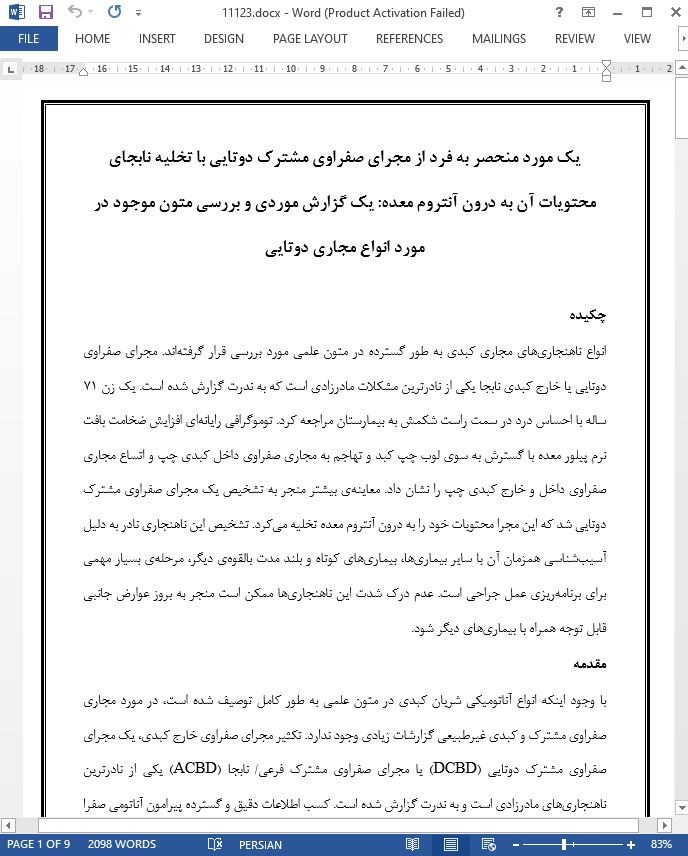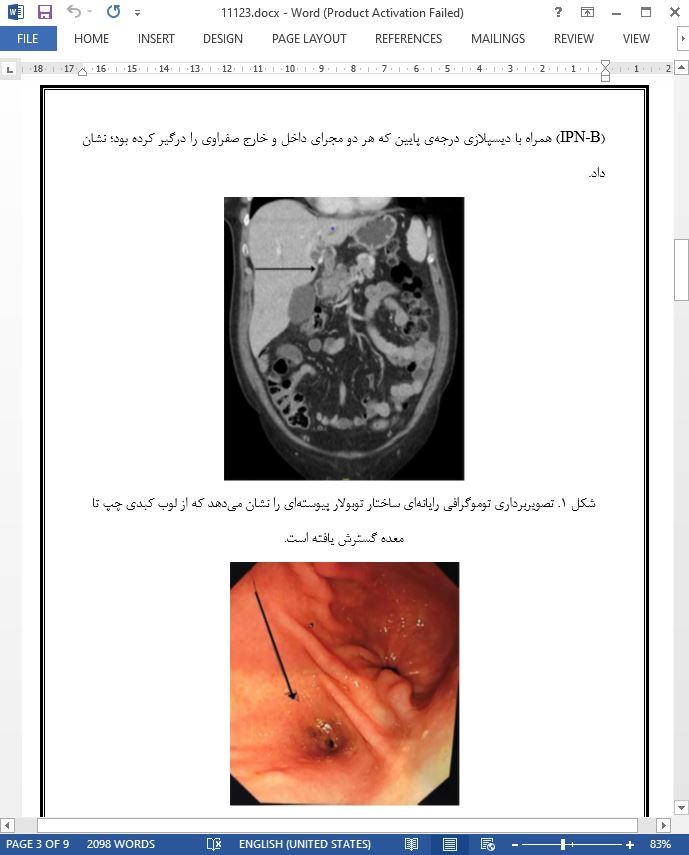
یک مورد منحصر به فرد از مجرای صفراوی مشترک دوتایی با تخلیه نابجای محتویات آن به درون آنتروم معده
چکیده
انواع ناهنجاری های مجاری کبدی به طور گسترده در متون علمی مورد بررسی قرار گرفته اند. مجرای صفراوی دوتایی یا خارج کبدی نابجا یکی از نادرترین مشکلات مادرزادی است که به ندرت گزارش شده است. یک زن 71 ساله با احساس درد در سمت راست شکمش به بیمارستان مراجعه کرد. توموگرافی رایانه ای افزایش ضخامت بافت نرم پیلور معده با گسترش به سوی لوب چپ کبد و تهاجم به مجاری صفراوی داخل کبدی چپ و اتساع مجاری صفراوی داخل و خارج کبدی چپ را نشان داد. معاینه ی بیشتر منجر به تشخیص یک مجرای صفراوی مشترک دوتایی شد که این مجرا محتویات خود را به درون آنتروم معده تخلیه می کرد. تشخیص این ناهنجاری نادر به دلیل آسیب شناسی همزمان آن با سایر بیماری ها، بیماری های کوتاه و بلند مدت بالقوه ی دیگر، مرحله ی بسیار مهمی برای برنامهریزی عمل جراحی است. عدم درک شدت این ناهنجاریها ممکن است منجر به بروز عوارض جانبی قابل توجه همراه با بیماری های دیگر شود.
نتیجه گیری
اطلاعات صحیح و دقیق پیرامون آناتومی صفرا و تغییرات آن جهت برنامه ریزی قبل از عمل جراحی به منظور به حداقل رساندن عوارض جانبی بعد از عمل ضروری است. آگاهی از احتمال بروز این ناهنجاری های خاص و پیچیده میزان مرگ و میر و ناخوشی ناشی از این بیماری ها را کاهش می دهد. در مواردی که ناهنجاری ها به دلیل تخلیه ی نابجای صفرا و جریان برگشتی مزمن شدید هستند؛ خطر بدخیمی بایستی در نظر گرفته شود و عمل جراحی و معاینات بعدی عوارض جانبی را برطرف خواهند کرد.
Abstract
Variants of hepatic duct anomalies are widely discussed in the literature. Duplication producing a double and/or aberrant extrahepatic bile duct is one of the rarest congenital variants that have been sparingly reported. A 71-year-old female presented with right-sided abdominal pain. Computerized tomography demonstrated an enhancing soft tissue thickening in the gastric pylorus with extension into the left lobe of the liver and invasion of the left intrahepatic bile ducts and dilatation of the left intra- and extrahepatic biliary tract. Further examination led to a diagnosis of a double common bile duct with ectopic drainage into the gastric antrum. Recognition of this rare anomaly is of great importance because of the implications in respect of concomitant pathology, the potential short- and long-term sequelae and crucially for operative planning. Failing to appreciate the extent of anomalies may result in significant complications with the attendant morbidity.
CONCLUSION
Accurate and detailed knowledge of the biliary anatomy and its variations are essential for preoperative planning to minimize postoperative complications. Awareness of the possibility of these major and complex anomalies should increase their reported incidence and decrease the potentially severe associated morbidity and mortality. Where the anomalies are extensive, associated with ectopic drainage and chronic ref lux, the associated risk of malignancy must be appreciated, and the surgical procedure and consequent surveillance modified to obviate the consequences.
چکیده
مقدمه
گزارش موردی
بحث
نتیجه گیری
Abstract
INTRODUCTION
CASE REPORT
DISCUSSION
CONCLUSION
- اصل مقاله انگلیسی با فرمت ورد (word) با قابلیت ویرایش
- ترجمه فارسی مقاله با فرمت ورد (word) با قابلیت ویرایش، بدون آرم سایت ای ترجمه
- ترجمه فارسی مقاله با فرمت pdf، بدون آرم سایت ای ترجمه



